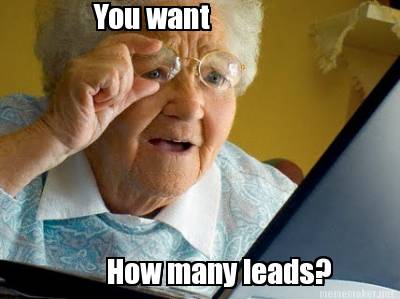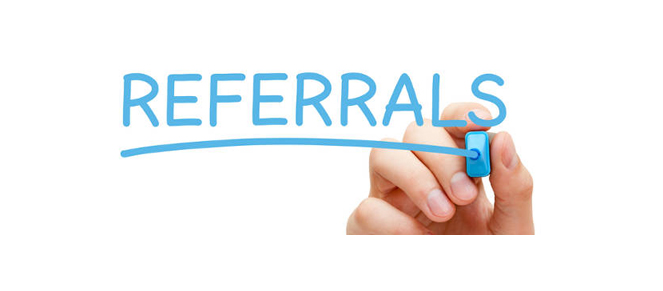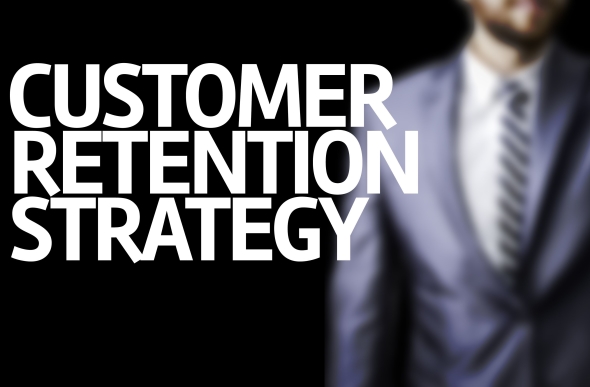 If you’re going to be successful selling insurance, the number one priority is getting in front of enough people to qualify them regarding their insurance needs. Basically, your job is to process people, and lots of them – how you do it is the one of the most tremendous obstacles new agents must overcome. In sales, any potential candidate for the type of product you are selling (Medicare Supplements, Final Expense, critical illness, etc.) is considered a suspect, according to Al Granum. If they express any interest, they are now considered a lead. It is the job of the agent to find or generateas many of these prospects as possible. Because, simply put: Without leads, you don’t have clients. Agents have tons of questions about ordering leads in order to get in front of these prospects:
If you’re going to be successful selling insurance, the number one priority is getting in front of enough people to qualify them regarding their insurance needs. Basically, your job is to process people, and lots of them – how you do it is the one of the most tremendous obstacles new agents must overcome. In sales, any potential candidate for the type of product you are selling (Medicare Supplements, Final Expense, critical illness, etc.) is considered a suspect, according to Al Granum. If they express any interest, they are now considered a lead. It is the job of the agent to find or generateas many of these prospects as possible. Because, simply put: Without leads, you don’t have clients. Agents have tons of questions about ordering leads in order to get in front of these prospects:
- How many leads should I order?
- How much should I pay?
- What kind of lead types are there?
- Whichtype of leads are best?
- Where can I find these leads, and which vendors can I trust?
But before we get too far into the topic, let’s lay out some basic definitions.
What is a Lead?
This is how we define leads in our book: Leads are prospective consumers who have either directly or indirectly expressed interest in a product or solution. Just because these people have expressed interest doesn’t mean they are necessarily ready to enroll in an insurance plan today; they may be in a different stage of the buying cycle. Just how much interest someone has expressed determines how cold or warm the lead is. If they went out of their way to fill out and mail in a card to request more info about life insurance, for example, they’re closer to a sale (warmer) than a cold lead you just called out of the blue. The first one gives you permission to market to them, which naturally makes them a better qualify lead; the second one was interrupted by your marketing, and may not even be qualified. Once you qualify a lead’s need for a plan, budget to afford a plan, and health conditions covered by a plan, it gets even warmer. 
Cold leads can warm up over time, but most agents who sell insurance prefer to spend their time qualifying and closing prospects instead of prospecting for them – which enables agents to earn more. By understanding the different types of leads and their nuances, you’ll be better equipped to order the right type of lead for your business. A quick side note before diving into the different types of insurance leads–leads come in two main flavors: they can be either shared or exclusive. An exclusive lead is sold to one insurance agent, but shared leads are sold to several agents at once, which means you’re competing in a race to the phone to dial each lead before another agent beats you to it. We always recommend exclusive leads because if you’re going to invest money into a lead campaign, you might as well pay for the whole lead instead of splitting it with your competition.
Comparing Lead Sources
There are lots of different ways to generate leads. I like this analogy from Agency Bloc: Saying that you want to buy “leads” is a bit like telling your waiter at a restaurant that you want to buy “food.” If you aren’t specific about what you want, you may be disappointed by what you get. Insurance leads come in many flavors. Most agents rely on these 9 most popular lead sources:
- Door Knocking
- Cold Calling
- Telemarketed Leads
- Direct Mail Leads
- Internet Leads
- Radio Leads
- TV Leads
- Seminar Leads
- Referrals
We’ll be covering each of these lead generation methods in more depth on our Advanced Lead Guide blog series, so keep checking back for tips, scripts and strategies specific to each one. For now, we at least want to summarize the pros and cons of each approach to help agents decide what kind of leads they should order.
Pros vs. Cons
| LEAD TYPE | PROS | CONS |
|---|---|---|
| Door Knocking Leads | ⦁ Cheapest ⦁ Gets you out of the office | ⦁ Lots of time prospecting = less time presenting ⦁ Laborious ⦁ cold lead source ⦁ Interruptive marketing ⦁ Potential solicitation limitations |
| Cold Calling Leads | ⦁ Cheapest ⦁ Reach more people in less time compared to door knocking | ⦁ Lots of time prospecting = less time presenting ⦁ Laborious ⦁ Cold lead source ⦁ Interruptive marketing ⦁ Potential Do Not Call limitations |
| Telemarketed Leads | ⦁ Cheaper than many sources ⦁ Warmer leads ⦁ Outsources the laborious task of dialing | ⦁ Interruptive marketing = tougher lead source ⦁ High competition |
| Direct Mail Leads | ⦁ Proof of lead’s request for more info ⦁ Warmer leads ⦁ Permissive marketing | ⦁ Expensive ⦁ Leads are warmer but still require sales effort and education ⦁ Mail houses may have exclusive territory policies ⦁ Ambiguous language on mailers can attract unqualified leads |
| Internet Leads | ⦁ Proof of lead’s request for more info ⦁ Warmer leads, who are potentially more receptive to digital marketing ⦁ Permissive marketing | ⦁ Very expensive ⦁ High competition ⦁ Potential for fraud online makes seniors leery |
| Seminar Leads | ⦁ Easy to appear an expert = trust ⦁ Multiple presentations in one ⦁ More qualified leads than DM because of time investment ⦁ Warmer lead ⦁ Permissive marketing | ⦁ Very expensive ⦁ Time-consuming ⦁ Requires public speaking skill (or at least comfort) ⦁ May require knowledge of CMS marketing requirements |
| Referrals | The Gold Standard: ⦁ Warmest leads possible = High trust ⦁ Low to no cost | ⦁ Hard to obtain ⦁ Takes time to build a referable reputation ⦁ Need online foundation to help sell your services |
Which Type of Lead is the Best?
Different lead sources may work better for some agents than others, based on lots of factors, like:
- Your local marketsaturation
- How much competition you face
- Your lead budget
- Your sales approach and experience
- The type of insurance you sell
The question of which types of leads are best, then, really depends on each individual agent. Sure, maybe the best lead is one who comes to you, either through a referral or through one of the 111 free lead ideas we shared in a previous post. But I’ve said it before and I’ll say it again: I think the smartest thing agents can do is diversify their marketing. It’s not about only buying internet leads or only relying on direct mail responses; the most successful agents diversify into an evolving mix of internet marketing, direct mail, telemarketing, referrals, and even sometimes door knocking, to supplement a steady flow of leads to fill their pipeline. A new agent probably won’t be able to afford expensive internet leads out of the gate, let alone pricey radio or TV ads, while seasoned insurance sales professionals might outgrow the need for cold calling. As a new agent starting out, you’re going to want the cheapest leads you can get your hands on, at least until the commissions start rolling in and you build your confidence as a salesman and can afford warmer, more qualified leads (which can often be more expensive).
DM OR TM LEADS?
So which type of lead is best? I may be biased, because Lead Heroes focuses on telemarketed leads, but in my earlier years as a producing agent, I tried all different types of leads to fuel my sales. Here’s what I think: Direct mail can produce higher quality leads because consumers have to take the initiative to fill out the card, sign their name, and mail it back. However, this advantage also makes DM slightly more expensive – most mail houses require minimum orders of at least 1,000-2,000 pieces, averaging about $450-$900 per campaign. Final Expense mailers typically generate a 1% return, which is 10 replies per 1,000 pieces, making each lead cost about $45. Medicare Supplement mailers often get a slightly higher return of 2-3%, which means each Med Sup lead costs between $15-$22.  Telemarketed leads are less expensive than direct mail, costing as little as $7-$10 apiece, depending how many you order, as many lead providers offer bulk discounts. Plus, because phone calls are faster than snail mail, agents can start receiving telemarketed leads within a couple of days. Telemarketing leads can be one of the best options for new agents because they offer an inexpensive way to start (and quickly see results from) a marketing campaign, giving agents more opportunities to approach and present prospects, which gives them practice to build their sales proficiency. Of course, if the agent doesn’t have a solid process in place, he might want to mix telemarketing leads in with some direct mail leads to not only diversify the lead source, but to mix in warmer leads while leveraging the card to get in the door.
Telemarketed leads are less expensive than direct mail, costing as little as $7-$10 apiece, depending how many you order, as many lead providers offer bulk discounts. Plus, because phone calls are faster than snail mail, agents can start receiving telemarketed leads within a couple of days. Telemarketing leads can be one of the best options for new agents because they offer an inexpensive way to start (and quickly see results from) a marketing campaign, giving agents more opportunities to approach and present prospects, which gives them practice to build their sales proficiency. Of course, if the agent doesn’t have a solid process in place, he might want to mix telemarketing leads in with some direct mail leads to not only diversify the lead source, but to mix in warmer leads while leveraging the card to get in the door.  Of course, your preference and experience may differ from our recommendations, depending on the market and specific niche you’re prospecting. Finding your own most effective lead source is often a matter of experimentation, so here are three tips for tapping into the best leads:
Of course, your preference and experience may differ from our recommendations, depending on the market and specific niche you’re prospecting. Finding your own most effective lead source is often a matter of experimentation, so here are three tips for tapping into the best leads:
- Test it out. You might have to test (and carefully track) hundreds of leads of each type from a few different (reputable, highly recommended) vendors before you can determine your own averages to decide which source works best for you.
- Research first. Before you try any new lead source, do your homework to make sure you’re choosing a lead vendor with a favorable reputation. Look online for reviews, and ask fellow agents about their experiences with various lead providers on a forum like www.insurance-forums.net.
- Check yourself. As important as quality leads are to any sale, it’s important to remember that leads are not the only factor that determines a sale. Ultimately, the agent’s ability to approach, handle, and build trust with each lead – no matter how warm or cold it is when he buys it – could impact that lead’s decision. It takes a lot of ongoing diligent work to turn a lead into a client, so before you blame your lead source for your sales record, take an objective look at your sales process to see how you can improve your odds.
- Don’t give up. Don’t expect every lead to answer, let alone buy, right away – some prospects take time because you haven’t built up enough trust or expertise in their eyes, or maybe they aren’t ready yet to make the change. It’s important to have a solid follow up process to check back with leads over time, maybe afte ran important life event forces them to address any potential problems that the insurance you sell solves.
How Many Leads Should I Buy?
 This is easily one of the most common questions I hear from new agents. The forums are full of agents asking each other, “How many leads should I order every week? How many leads do I need? How much will they cost? And how many can I sell?” Ultimately, it depends what you’re selling and how you’re selling it. To figure out how many leads you need to order, work backward from your desired monthly income to figure out how many policies you need to sell to meet that goal, and then how many leads it takes you to make one sale. Our book goes through this math in more detail, so you can find more specific examples and explanations there. As a rough average, most agents close at least 10-15% of the leads they order. Final Expense agents typically sell about two plans for every 10 direct mail leads, while Medicare Supplement agents might sell one (depending on the time of year and the Medicare Advantage Penetration Rate). It usually takes more telemarketed leads to make a sale because it’s a more interruptive marketing method and leads are slightly colder. So, Final Expense agents may need 10 telemarketed leads to close one sale, while Med Supp agents may need 12. If telemarketed Final Expense leads cost $7-$10 apiece and a new agent sells one out of every 10, the lead cost for each sale is about $70-$100. Med Supp agents, who sell one of every 10-12 telemarketed leads, have to spend a little more to make one sale, about $100-$120. In a previous blog post, we established that Final Expense agents earn about $600 in first year commission for each plan sold, while Medicare Supplement agents average $360. When you subtract the lead costs from these commissions, you can figure out your average profit per sale, and then multiply that out to find how many leads you need to contact to make enough sales to hit your goal.
This is easily one of the most common questions I hear from new agents. The forums are full of agents asking each other, “How many leads should I order every week? How many leads do I need? How much will they cost? And how many can I sell?” Ultimately, it depends what you’re selling and how you’re selling it. To figure out how many leads you need to order, work backward from your desired monthly income to figure out how many policies you need to sell to meet that goal, and then how many leads it takes you to make one sale. Our book goes through this math in more detail, so you can find more specific examples and explanations there. As a rough average, most agents close at least 10-15% of the leads they order. Final Expense agents typically sell about two plans for every 10 direct mail leads, while Medicare Supplement agents might sell one (depending on the time of year and the Medicare Advantage Penetration Rate). It usually takes more telemarketed leads to make a sale because it’s a more interruptive marketing method and leads are slightly colder. So, Final Expense agents may need 10 telemarketed leads to close one sale, while Med Supp agents may need 12. If telemarketed Final Expense leads cost $7-$10 apiece and a new agent sells one out of every 10, the lead cost for each sale is about $70-$100. Med Supp agents, who sell one of every 10-12 telemarketed leads, have to spend a little more to make one sale, about $100-$120. In a previous blog post, we established that Final Expense agents earn about $600 in first year commission for each plan sold, while Medicare Supplement agents average $360. When you subtract the lead costs from these commissions, you can figure out your average profit per sale, and then multiply that out to find how many leads you need to contact to make enough sales to hit your goal.
Residual Commissions After the First Year
 Don’t forget to factor in residual commissions. The numbers above are only first-year commissions. Though Final Expense agents earn more commissions the first year (about 110% of the annual premium), the residuals drop to less than 10% the second year. Med Supp agents, on the other hand, earn the same commissions for the next five years if clients stay on the books. You may need fewer Final Expense leads to make one sale and earn higher commissions, but you’ll have to do about the same amount of work next year to maintain the same income. Meanwhile, you’d have to work more Medicare Supplement leads to learn a lower commission at first, but you can enjoy the same commission renewals for the next several years. In summary, you’ll need to understand several aspects of your own sales averages before you can determine how many leads you need to buy:
Don’t forget to factor in residual commissions. The numbers above are only first-year commissions. Though Final Expense agents earn more commissions the first year (about 110% of the annual premium), the residuals drop to less than 10% the second year. Med Supp agents, on the other hand, earn the same commissions for the next five years if clients stay on the books. You may need fewer Final Expense leads to make one sale and earn higher commissions, but you’ll have to do about the same amount of work next year to maintain the same income. Meanwhile, you’d have to work more Medicare Supplement leads to learn a lower commission at first, but you can enjoy the same commission renewals for the next several years. In summary, you’ll need to understand several aspects of your own sales averages before you can determine how many leads you need to buy:
- Average # of returns per lead generation campaign
- Average # of leads to set an appointment
- Average # of appointments to write a policy
- Average premium/commission per policy sold
- How many policies you have to sell, how frequently, to reach your annual income goal
Note: Don’t get too hung up on costs per lead; think about ROI instead. Cheaper leads may be a new agent’s best bet, and you can get more sales practice working more leads this way. But eventually, paying more money for fewer, more qualified leads might yield better results, and allow agents to focus on closing sales instead of sifting through leads.
Using Filters to Find the Best Leads
If an agent is going to be successful working his leads, he needs to make sure the leads are as qualified as possible. This is where filters come in, without them we’d be asking anyone randomly if they’re interested in the type of insurance we are selling. While that may yield some results, smart agents will make sure they are only marketing to the typical client profile that your insurance helps. The most common filters for insurance leads include:
- Age
- Income
- Geography (usually zip code or county)
Here’s what the filters might look like for the average Final Expense or Medicare Supplement agent, respectively:
| FILTER | PROS | MEDICARE SUPPLEMENT |
|---|---|---|
| AGE | 50-80 | 65-75 |
| INCOME | $15,000-$45,000 | $25,000 and up |
| AREA | Depends whether agent sells face-to-face locally or over the phone | Depends whether the agent sells face-to-face locally or over the phone |
Tinkering with these traditional filters, like increasing income filters or decreasing age filters, can potentially increase the number of leads you get. Just remember, increasing the number of leads doesn’t necessarily mean you will be getting more qualified leads, you may actually get more unqualified leads like people who are too poor to afford the insurance, or can’t qualify because their health is uninsurable. Spreading your net wider to get more leads, even if they’re potentially less qualified, does have certain benefits, especially if you’re advanced enough in sales techniques to fluidly cross-sell other types of insurance products and/or to fearlessly ask for referrals of others who may be in the market for what you’re selling.
Deciding which filters to set, just like deciding which types of leads to buy, ultimately depends what the agent is looking for. New agents might want to stick to basic filters and less expensive leads just to get in front of more people as they build their sales experience and earnings. More advanced agents, with referrals and residuals flowing in, can afford to spend a little more on leads and be more specific with their filters in order to focus their time on selling, rather than prospecting. What types of Final Expense leads or Medicare Expense do you prefer? How many do you have to buy and meet with to make a sale? Share your tips about ordering leads in the comment section below.









Thanks for the information on how Final Expense agents usually only need ten telemarketed leads to close one sale and Med Supp agents may need twelve. Since that is the case, choosing a job in Final Expense insurance would probably be a good idea. If you want to work in the business, you’d probably want to make sure you get the proper training so that you have the information and skills to find leads.